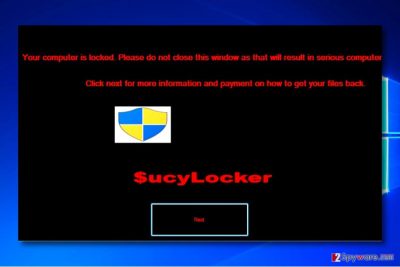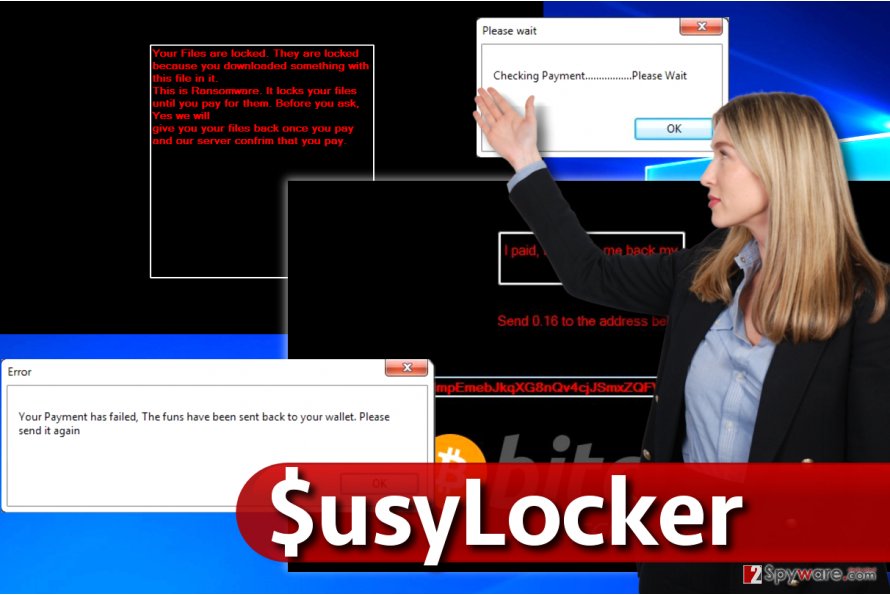$usyLocker ransomware / virus (Free Instructions) - Quick Decryption Solution
$usyLocker virus Removal Guide
What is $usyLocker ransomware virus?
$usyLocker ransomware locks victim's files for good, leaving no hope to recover them
$usyLocker ransomware is a HiddenTear-based[1] computer virus. It was built using open-source ransomware code, and it seems that the developer of it wasn’t really experienced.
The main executable of the ransomware is called VapeHacksLoader.exe. After infecting the computer, this ransomware encrypts files stored in the system and adds .WINDOWS file extension to each of them. Then it outputs some text into a ransom note READ_IT.txt which the virus saves on the desktop.
This virus aims to extort the victim as it asks 0.16 BTC in exchange for a decryption key. However, instead of paying, you should remove $usyLocker from your PC using tutorial provided below the article.

Ransomware can be identified easily
The ransom note (READIT.txt) contains just a few lines of text, saying “Your files have been encrypted. Read the Program for more information.”
$usyLocker also launches a black window with some red text on it: “Your computer is locked. Please do not close this window as that will result in serious computer damage. Click next for more information and payment on how to get your files back.” After clicking the “Next” button, the victim receives the following message:
Your files are locked. They are locked because you downloaded something with this file in it. This is Ransomware. It locks your files until you pay for them. Before you ask, Yes we will give you your files back once you pay and our server confrim that you pay.
Clicking the “Next” button once again takes the victim to a page that provides the price of data recovery (0.16 BTC) and the Bitcoin wallet address. Clicking the “I paid, Now give me back my files” button triggers a pop-up message that says “Checking Payment……Please Wait.” Then the virus displays another error message, saying that the payment has failed and the funds have been sent back to victim’s wallet. The virus urges the victim to transfer the cash again.

If this ransomware infected your computer, we highly suggest you begin $usyLocker removal procedure right away. We must inform you that this poorly programmed piece of malware doesn’t save the decryption key, therefore after the data encryption it becomes impossible to recover lost files.
The virus also doesn’t have a function that checks if the payment was transferred or not. For this reason, we urge you to remove $usyLocker ransomware using anti-malware tools like FortectIntego according to instructions provided below the article.
Distribution of the ransom-demanding viruses
Ransomware developers tend to distribute malicious viruses via malicious spam – all that it takes is to attach a malicious file to an email and send a copy of it to thousands of victims. After receiving such file, some people decide to open it, and that is the biggest mistake they can make.
Remember – you should never open files sent by strangers because they typically are malicious. Unfortunately, scammers find ways to bypass email spam filters and make the deceptive messages appear in victims’ Inbox folders.
Some ransomware developers choose to distribute these malicious programs using other means, for example, malvertising, phishing, social engineering, exploit kits[2] or trojan horses. The best way to protect yourself from a ransomware attack is to keep your software up-to-date, have a good anti-malware program as well as data backup.
Remove $usyLocker without a delay
Users who want to remove $usyLocker virus typically are unsure what is the right way to do it. For this reason, we have added an easy-to-follow removal tutorial at the end of this post. Please follow the provided $usyLocker removal instructions attentively. We want to inform you in advance that we do not recommend removing such programs manually, so you have to decide what anti-spyware or anti-malware program you are going to use.
Getting rid of $usyLocker virus. Follow these steps
Manual removal using Safe Mode
To delete the malware from your system and remove all of $usyLocker ransomware remains, please complete the given instructions.
Important! →
Manual removal guide might be too complicated for regular computer users. It requires advanced IT knowledge to be performed correctly (if vital system files are removed or damaged, it might result in full Windows compromise), and it also might take hours to complete. Therefore, we highly advise using the automatic method provided above instead.
Step 1. Access Safe Mode with Networking
Manual malware removal should be best performed in the Safe Mode environment.
Windows 7 / Vista / XP
- Click Start > Shutdown > Restart > OK.
- When your computer becomes active, start pressing F8 button (if that does not work, try F2, F12, Del, etc. – it all depends on your motherboard model) multiple times until you see the Advanced Boot Options window.
- Select Safe Mode with Networking from the list.

Windows 10 / Windows 8
- Right-click on Start button and select Settings.

- Scroll down to pick Update & Security.

- On the left side of the window, pick Recovery.
- Now scroll down to find Advanced Startup section.
- Click Restart now.

- Select Troubleshoot.

- Go to Advanced options.

- Select Startup Settings.

- Press Restart.
- Now press 5 or click 5) Enable Safe Mode with Networking.

Step 2. Shut down suspicious processes
Windows Task Manager is a useful tool that shows all the processes running in the background. If malware is running a process, you need to shut it down:
- Press Ctrl + Shift + Esc on your keyboard to open Windows Task Manager.
- Click on More details.

- Scroll down to Background processes section, and look for anything suspicious.
- Right-click and select Open file location.

- Go back to the process, right-click and pick End Task.

- Delete the contents of the malicious folder.
Step 3. Check program Startup
- Press Ctrl + Shift + Esc on your keyboard to open Windows Task Manager.
- Go to Startup tab.
- Right-click on the suspicious program and pick Disable.

Step 4. Delete virus files
Malware-related files can be found in various places within your computer. Here are instructions that could help you find them:
- Type in Disk Cleanup in Windows search and press Enter.

- Select the drive you want to clean (C: is your main drive by default and is likely to be the one that has malicious files in).
- Scroll through the Files to delete list and select the following:
Temporary Internet Files
Downloads
Recycle Bin
Temporary files - Pick Clean up system files.

- You can also look for other malicious files hidden in the following folders (type these entries in Windows Search and press Enter):
%AppData%
%LocalAppData%
%ProgramData%
%WinDir%
After you are finished, reboot the PC in normal mode.
Remove $usyLocker using System Restore
-
Step 1: Reboot your computer to Safe Mode with Command Prompt
Windows 7 / Vista / XP- Click Start → Shutdown → Restart → OK.
- When your computer becomes active, start pressing F8 multiple times until you see the Advanced Boot Options window.
-
Select Command Prompt from the list

Windows 10 / Windows 8- Press the Power button at the Windows login screen. Now press and hold Shift, which is on your keyboard, and click Restart..
- Now select Troubleshoot → Advanced options → Startup Settings and finally press Restart.
-
Once your computer becomes active, select Enable Safe Mode with Command Prompt in Startup Settings window.

-
Step 2: Restore your system files and settings
-
Once the Command Prompt window shows up, enter cd restore and click Enter.

-
Now type rstrui.exe and press Enter again..

-
When a new window shows up, click Next and select your restore point that is prior the infiltration of $usyLocker. After doing that, click Next.


-
Now click Yes to start system restore.

-
Once the Command Prompt window shows up, enter cd restore and click Enter.
Bonus: Recover your data
Guide which is presented above is supposed to help you remove $usyLocker from your computer. To recover your encrypted files, we recommend using a detailed guide prepared by 2-spyware.com security experts.Sadly, once the virus encrypts the data stored on the computer, it becomes impossible to recover them. Although you can try the methods given below, only a data backup can help you to recover some files.
If your files are encrypted by $usyLocker, you can use several methods to restore them:
Data Recovery Pro trick
Sometimes, Data Recovery Pro succeeds to recover some files encrypted by ransomware. You can try this tool in case the $usyLocker ransomware attacked your PC.
- Download Data Recovery Pro;
- Follow the steps of Data Recovery Setup and install the program on your computer;
- Launch it and scan your computer for files encrypted by $usyLocker ransomware;
- Restore them.
$usyLocker decrypter doesn't exist
Finally, you should always think about the protection of crypto-ransomwares. In order to protect your computer from $usyLocker and other ransomwares, use a reputable anti-spyware, such as FortectIntego, SpyHunter 5Combo Cleaner or Malwarebytes
How to prevent from getting ransomware
Do not let government spy on you
The government has many issues in regards to tracking users' data and spying on citizens, so you should take this into consideration and learn more about shady information gathering practices. Avoid any unwanted government tracking or spying by going totally anonymous on the internet.
You can choose a different location when you go online and access any material you want without particular content restrictions. You can easily enjoy internet connection without any risks of being hacked by using Private Internet Access VPN.
Control the information that can be accessed by government any other unwanted party and surf online without being spied on. Even if you are not involved in illegal activities or trust your selection of services, platforms, be suspicious for your own security and take precautionary measures by using the VPN service.
Backup files for the later use, in case of the malware attack
Computer users can suffer from data losses due to cyber infections or their own faulty doings. Ransomware can encrypt and hold files hostage, while unforeseen power cuts might cause a loss of important documents. If you have proper up-to-date backups, you can easily recover after such an incident and get back to work. It is also equally important to update backups on a regular basis so that the newest information remains intact – you can set this process to be performed automatically.
When you have the previous version of every important document or project you can avoid frustration and breakdowns. It comes in handy when malware strikes out of nowhere. Use Data Recovery Pro for the data restoration process.
- ^ Jornt van der Wiel. Hidden tear and its spin offs. Securelist. Information about Viruses, Hackers and Spam.
- ^ Ed Cabrera. Exploits as a Service: How the Exploit Kit + Ransomware Tandem Affects a Company’s Bottom Line. Trend Micro Blogs. Simply Security News, Views and Opinions.





















